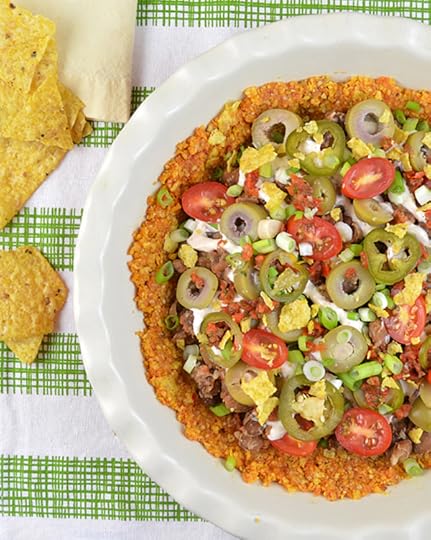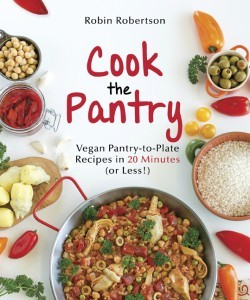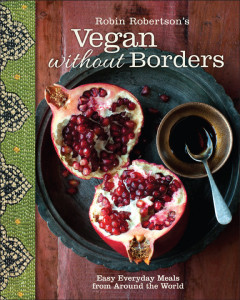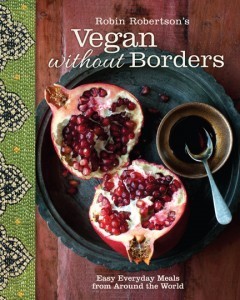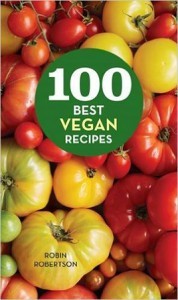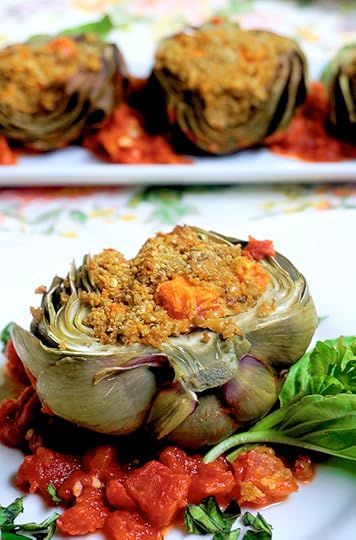Robin Robertson's Blog, page 8
May 1, 2018
Pinto Bean Nacho Pie
Everything you love about nachos comes together in this savory Pinto Bean Nacho Pie. You can substitute black beans for the pintos, if desired. Serve for lunch, dinner, or a snack.
This recipe is from my book Cook the Pantry © 2015, Vegan Heritage Press. Photo by Zsu Dever.
Pinto Bean Nacho Pie

Everything you love about nachos comes together in this savory pie. You can substitute black beans for the pintos, if desired. Serve for lunch, dinner, or a snack. Makes 4 to 6 servings.
Crust:
1/2 cup raw cashews, soaked 3 hours, then drained
1 tablespoon roasted red bell pepper or jarred pimientos, blotted dry
1 garlic clove crushed
1 tablespoon cider vinegar
2 tablespoons nutritional yeast
1/4 teaspoon salt
1/4 teaspoon onion powder
1/4 teaspoon smoked paprika or chili powder
1/8 teaspoon ground turmeric
1/4 cup unrefined coconut oil, melted
2 cups corn chips, crushed
Toppings:
1/3 cup vegan sour cream
1/4 teaspoon chili powder or to taste
1 (15-ounce) can pinto beans, drained and rinsed
3/4 cup tomato salsa
1/3 cup bottled sliced jalapenos
1/2 cup chopped pitted Kalamata olives
Crust: In a food processor or high-speed blender, combine the cashews, roasted red bell pepper, garlic, and vinegar. Process until the mixture is pureed and smooth. Add the nutritional yeast, salt, onion powder, paprika, and turmeric. Process until smooth, scraping down the sides as needed. Add the melted coconut oil and process until the mixture is completely smooth, scraping down the sides as needed. Transfer the mixture to a bowl. Stir in the crushed corn chips, mixing well. Press the mixture into a lightly oiled 9-inch pie plate, cake pan, or springform pan. Cover and refrigerate for 3 hours to firm up.
Toppings: While the crust is chilling, prepare the toppings. In a small bowl, combine the sour cream and chili powder. Set aside. In a small saucepan, combine the beans and salsa and cook, stirring, until heated through. Keep warm.
To serve: Top the crust with the warm beans and salsa mixture, jalapenos, and olives. Drizzle with the reserved sour cream. Cut into wedges and serve.
Recipe from Cook the Pantry © 2015 by Robin Robertson. Photo by Zsu Dever. Used by permission Vegan Heritage Press LLC.
The post Pinto Bean Nacho Pie appeared first on Robin Robertson.












April 24, 2018
Vegetable Pan Bagnat
Pan bagnat is the “bathed bread” sandwich from the south of France. Typically it contains tuna, but you won’t miss the fish with all the great flavors going on in this vegan version. Since this sandwich must be prepared in advance in order for the bread to become flavored with the other ingredients, it makes a great choice for a picnic.
Vegetable Pan Bagnat

Pan bagnat is the “bathed bread” sandwich from the south of France. Typically it contains tuna, but you won’t miss the fish with all the great flavors going on in this vegan version. Since this sandwich must be prepared in advance in order for the bread to become flavored with the other ingredients, it makes a great choice for a picnic.
2 large portobello mushroom caps, gills scraped out
2 tablespoons olive oil
2 tablespoons sherry vinegar
1 tablespoon tamari soy sauce
1/2 teaspoon Dijon mustard
1 1/2 cups cooked white beans, or 1 (15-ounce) can white beans, drained and rinsed
3 cloves garlic cloves, crushed
1/4 cup tahini, sesame paste
2 tablespoons minced reconstituted or oil-packed sundried tomato
3 tablespoons freshly squeezed lemon juice
2 tablespoons water
Salt and freshly ground black pepper
1 large round crusty bread loaf
2 roasted red bell peppers, home-roasted or jarred, cut into strips
1 6-ounce jar marinated artichoke hearts, drained and sliced
1 cup packed baby spinach or kale leaves
1 large ripe tomato, thinly sliced
1/3 cup pitted and chopped kalamata olives
Cut the mushroom caps into very thin slices. Heat 1 tablespoon of the oil in a large skillet over medium-high heat. Working in batches, add the mushroom slices and sear on both sides. Season with salt and pepper to taste. Transfer the cooked mushrooms to a plate and cook the remaining mushrooms slices. When all the mushrooms are cooked, combine them all in the skillet and set aside.
In a small bowl, combine the vinegar, soy sauce, and mustard, stirring to blend. Pour the mixture over the mushrooms, turning to coat. Set aside to cool.
In a food processor, combine the white beans and garlic and process to a paste. Add the tahini, sun-dried tomatoes, lemon juice, water, and salt and pepper to taste. Process until smooth. Set aside.
Use a serrated knife to cut the bread in half horizontally. Use your hands to pinch out the soft center of the bread from inside both halves of the loaf to make room for the filling.
Spread the white bean mixture inside the both halves of the loaf. Remove the mushrooms from the marinade and layer them over the white bean mixture, alternating with layers of the roasted peppers, artichoke hearts, spinach, tomato, and olives. Drizzle with the remaining marinade and season with salt and pepper to taste. Replace the top half of the loaf and wrap the entire loaf tightly in plastic. Place the sandwich on a large plate and top with another plate, lid or pan. Weigh the top down with canned goods. Refrigerate for at least 4 hours or up to 12 hours. When ready to serve, unwrap the sandwich and cut it with a serrated knife into 4 four to 6 six wedges.
This recipe is from Vegan Without Borders © Robin Robertson, 2014, Andrews McMeel Publishing, photo by Zsu Dever.
The post Vegetable Pan Bagnat appeared first on Robin Robertson.












April 17, 2018
Roasted Niçoise Salad with Cashew Goddess Dressing
 Roasting the potatoes and green beans adds a new layer of flavor to this hearty Niçoise Salad. A creamy cashew dressing provides a rich finish. To make this soy free, use coconut aminos instead of tamari.
Roasting the potatoes and green beans adds a new layer of flavor to this hearty Niçoise Salad. A creamy cashew dressing provides a rich finish. To make this soy free, use coconut aminos instead of tamari.
Roasted Niçoise Salad with Cashew Goddess Dressing
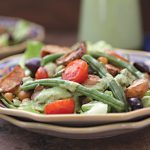
Roasting the potatoes and green beans adds a new layer of flavor to this hearty Niçoise Salad. A creamy cashew dressing provides a rich finish. To make this soy free, use coconut aminos instead of tamari.
1 pound small new potatoes, halved or cut into 1/2-inch pieces
8 ounces green beans, steamed
1 1/2 cups cooked or 1 (15.5-ounce) can chickpeas, drained and rinsed
1 cup cherry or grape tomatoes, halved lengthwise
1/3 cup cashews
2 scallions, chopped
1 garlic clove, crushed
3 tablespoons chopped fresh parsley
1/2 cup plain unsweetened almond milk
2 tablespoons tahini
2 tablespoons rice vinegar
1 tablespoon fresh lemon juice
1 tablespoon wheat-free tamari
1/2 teaspoon salt
1/3 cup kalamata olives, pitted and halved
Torn butter lettuce leaves, to serve
Preheat the oven to 425°F. Arrange the potatoes on a lightly oiled baking pan and spray with a little cooking spray. Season to taste with salt and pepper and roast until just softened and lightly browned, turning once, about 25 minutes. Add the steamed green beans, chickpeas, and tomatoes. Season with salt and pepper, and spray with a little cooking spray. Return to the oven for 15 minutes.
While the vegetables are roasting, make the dress- ing. Grind the cashews in a high-speed blender. If you don’t have a high-speed blender, you can use a food processor but the dressing won’t be as smooth. Add the scallions, garlic, and parsley. Pulse to mince. Add the almond milk, tahini, vinegar, lemon juice, tamari, and salt to taste; process until smooth. Set aside.
When the vegetables are roasted, remove from the oven and allow to cool to room temperature.
To serve, arrange the lettuce leaves onto four serving plates. Arrange the vegetables on top and drizzle each salad with some of the dressing. Serve immediately.
From The Nut Butter Cookbook by Robin Robertson. ©2014 Robin Robertson. Used by permission from Andrews McMeel Publishing. Photo by Lori Maffei.
The post Roasted Niçoise Salad with Cashew Goddess Dressing appeared first on Robin Robertson.












April 10, 2018
24-hour Kimchi
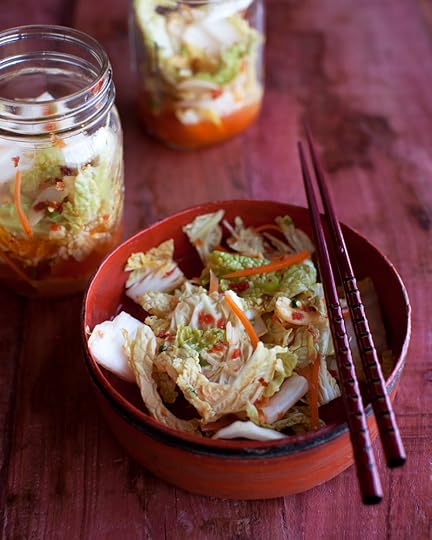 If you go to an Asian market to buy kimchi, the fermented vegetable side dish, be ready for a lot of choices. In addition to several prepared varieties sold in jars, you may be faced with vendors selling their own homemade kimchi from large tubs. While there are similarities to them, each batch of kimchi is as unique as the cook who made it. Cabbage dominates in the most familiar versions, but other ingredients such as daikon radish, carrots, and other vegetables may be included as well, with varying degrees of spiciness. With all those choices, it may be easier to make your own, using this recipe as a starting point, adding more or less garlic, cayenne, or kochijan paste according to taste.
If you go to an Asian market to buy kimchi, the fermented vegetable side dish, be ready for a lot of choices. In addition to several prepared varieties sold in jars, you may be faced with vendors selling their own homemade kimchi from large tubs. While there are similarities to them, each batch of kimchi is as unique as the cook who made it. Cabbage dominates in the most familiar versions, but other ingredients such as daikon radish, carrots, and other vegetables may be included as well, with varying degrees of spiciness. With all those choices, it may be easier to make your own, using this recipe as a starting point, adding more or less garlic, cayenne, or kochijan paste according to taste.
Traditionally kimchee kimchi is left at room temperature for a few days (or longer) to ferment, but my version takes just 24 hours, although the fermentation process will continue (albeit more slowly) once the kimchee kimchi is refrigerated.
Kimchi is rich in vitamins, iron, calcium, and iron, and also low in fat and high in fiber, kimchi’s ; its greatest health benefit is a result of its fermentation process that creates good or “healthy” bacteria (the same kind found in yogurt or sauerkraut) which in turn, preserves the vegetables and gives them their distinctive tangy flavor.
24-hour Kimchi

Traditionally kimchee kimchi is left at room temperature for a few days (or longer) to ferment, but my version takes just 24 hours, although the fermentation process will continue (albeit more slowly) once the kimchee kimchi is refrigerated.
5 cups coarsely chopped napa cabbage
1 carrot, peeled and thinly sliced
1/2 cup chopped scallions
4 cups water
2 teaspoons salt
3 cloves garlic cloves
1 teaspoon grated fresh ginger
1 tablespoon cayenne or 2 tablespoons kochijan paste combined with 1 tablespoon hot water
2 tablespoons rice vinegar
1/4 teaspoon freshly ground black pepper
In a large bowl, combine the cabbage, carrot, and scallion. Add the salt and water. Place a plate inside the bowl to hold the vegetables under water. Cover and set aside for 4 hours.
Drain well and discard the salt water. Rinse the vegetables well and drain again, squeezing out any remaining liquid.
In a small bowl, combine the garlic, ginger, cayenne mixture, vinegar, and pepper. Mix well. Add to the reserved vegetables and mix well to coat.
Cover tightly and set aside on the kitchen counter to ferment overnight. Taste and adjust the seasonings, if needed. Store in an airtight container in the refrigerator where it will continue to ferment at a slower rate. Properly stored, the kimchi will keep in the refrigerator for several weeks.
This recipe is from Vegan Without Borders © Robin Robertson, 2014, Andrews McMeel Publishing, photo by Sara Remington.
The post 24-hour Kimchi appeared first on Robin Robertson.












April 3, 2018
Lemongrass Asparagus and Edamame Stir-fry
 This dish is filled with the fresh fragrant flavors of lemongrass and cilantro, and loaded with edamame, asparagus, carrots, cashews, and other goodies. This Lemongrass Asparagus and Edamame Stir-fry is seasoned with a luscious sauce made with vegan oyster sauce, rice vinegar, and sambal oelek, a paste of ground hot chiles. Even though it’s a long list of ingredients, it goes together quickly – —the hardest thing about this stir-fry is not eating the whole thing yourself in one sitting.
This dish is filled with the fresh fragrant flavors of lemongrass and cilantro, and loaded with edamame, asparagus, carrots, cashews, and other goodies. This Lemongrass Asparagus and Edamame Stir-fry is seasoned with a luscious sauce made with vegan oyster sauce, rice vinegar, and sambal oelek, a paste of ground hot chiles. Even though it’s a long list of ingredients, it goes together quickly – —the hardest thing about this stir-fry is not eating the whole thing yourself in one sitting.
Lemongrass Asparagus and Edamame Stir-fry

This dish is filled with the fresh fragrant flavors of lemongrass and cilantro, and loaded with edamame, asparagus, carrots, cashews, and other goodies. It’s seasoned with a luscious sauce made with vegan oyster sauce, rice vinegar, and sambal oelek, a paste of ground hot chiles. Even though it’s a long list of ingredients, it goes together quickly – —the hardest thing about this stir-fry is not eating the whole thing yourself in one sitting.
1/4 cup soy sauce
1/4 cup water
2 tablespoons vegan oyster sauce
2 tablespoons rice vinegar
1 teaspoon sambal oelek (ground fresh chili paste)
1 teaspoon ground coriander
1 teaspoon natural sugar
1 tablespoon neutral vegetable oil
1 medium yellow onion, halved lengthwise, then thinly sliced
3 cloves garlic cloves, minced
2 fresh lemongrass stalks, tender inner white bulb only, minced
1 teaspoon grated fresh ginger
12 ounces thin asparagus, trimmed, and cut diagonally into 1 1/2-inch pieces
1 red bell pepper, seeded and cut into julienne strips
1 cup steamed fresh or frozen shelled edamame
2 medium-size carrots, coarsely shredded
1/2 cup chopped fresh cilantro or basil
1/4 cup toasted cashews
3 to 4 cups freshly cooked long-grain rice (for serving)
In a small bowl, combine the soy sauce, water, oyster sauce, vinegar, sambal oelek, coriander, and sugar. Stir to mix well. Set aside.
Heat the oil in a large wok or large skillet over high heat. Add the onion, garlic, lemongrass, and ginger, and stir-fry for 30 seconds. Add the asparagus, bell pepper, edamame, and carrots. Stir-fry for 3 minutes, then stir in the reserved sauce and bring to a boil. Lower the heat to a simmer and cook for about 3 minutes to reduce the sauce a little. Stir in the cilantro and cashews. Taste and adjust the seasonings if needed. Serve hot with rice.
Note: Vegan oyster sauce is sold at Asian markets –— it is labeled as “vegetarian” oyster sauce. If unavailable, look for mushroom soy sauce. If you can’t find either, you can omit it and just add a little extra of your regular soy sauce, as needed.
This recipe is from Vegan Without Borders © Robin Robertson, 2014, Andrews McMeel Publishing, photo by Sara Remington.
The post Lemongrass Asparagus and Edamame Stir-fry appeared first on Robin Robertson.












March 27, 2018
Saffron-Almond Rice Pudding
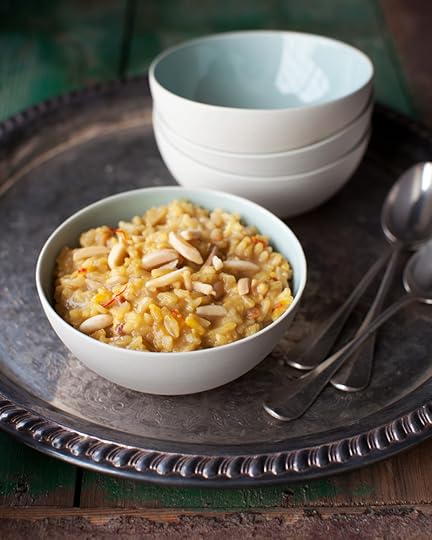 I prefer to make rice pudding using leftover cooked rice rather than starting from scratch with raw rice because it’s quicker and it’s a great way to use leftover rice. My favorite rice for rice pudding is brown basmati rice, but if you like a creamier texture, try sushi rice, arborio rice, or jasmine rice.
I prefer to make rice pudding using leftover cooked rice rather than starting from scratch with raw rice because it’s quicker and it’s a great way to use leftover rice. My favorite rice for rice pudding is brown basmati rice, but if you like a creamier texture, try sushi rice, arborio rice, or jasmine rice.
Saffron-Almond Rice Pudding

I prefer to make rice pudding using leftover cooked rice (rather than starting from scratch with raw rice because it’s quicker and it’s a great way to use leftover rice. My favorite rice for rice pudding is brown basmati rice, but if you like a creamier texture, try sushi rice, arborio rice, or jasmine rice.
1 tablespoon pure maple syrup or agave nectar
1 tablespoon almond butter
2 teaspoons natural sugar
1/2 teaspoon ground cinnamon
Few pinches saffron
1/8 teaspoon salt
1 cup almond milk
2 cups cooked basmati rice (or your favorite rice)
1/2 cup toasted slivered almonds
In a small saucepan, combine the maple syrup, almond butter, sugar, cinnamon, saffron, and salt over medium heat. Slowly add the almond milk, stirring to blend. Add the cooked rice and cook, stirring until the rice is heated through and the mixture begins to thicken. Decrease the heat to medium-low, stirring occasionally, until the desired consistency is reached. For a thinner pudding, add a little more almond milk. For a creamier texture, use an immersion blender to blend a portion of the rice pudding right in the saucepan. To serve spoon the pudding into bowls and sprinkle with toasted almonds.
This recipe is from Vegan Without Borders © Robin Robertson, 2014, Andrews McMeel Publishing, photo by Sara Remington.
This recipe is from Vegan Without Borders © Robin Robertson, 2014, Andrews McMeel Publishing, photo by Sara Remington.
The post Saffron-Almond Rice Pudding appeared first on Robin Robertson.












March 20, 2018
Vegan Coconut Cupcakes
 These vegan Coconut Cupcakes look especially pretty with toasted large flakes of toasted coconut sprinkled on the frosting. They’re a great treat to serve on Easter.
These vegan Coconut Cupcakes look especially pretty with toasted large flakes of toasted coconut sprinkled on the frosting. They’re a great treat to serve on Easter.
Coconut Cupcakes
These cupcakes look especially pretty with toasted large flakes of toasted coconut sprinkled on the frosting.
Cupcakes:
3/4 cup coconut milk
1 teaspoon apple cider vinegar
1 1/4 cups all-purpose flour
2 tablespoons cornstarch
1 teaspoon ground nutmeg
1/ teaspoon salt
1 teaspoon baking powder
1/4 teaspoon baking soda
1/ teaspoon salt
3/4 cup granulated sugar
3 tablespoons coconut oil, melted
1 teaspoon coconut extract
Frosting:
1/3 cup vegan butter
2 cups confectioners’ sugar
1 teaspoon coconut extract
Lightly toasted flaked coconut (for garnish)
Cupcakes: Preheat the oven to 350° degrees F. Line a 12-cup muffin tin with cupcake liners. Set aside.
In a small bowl, combine the coconut milk and vinegar and set aside. In a medium bowl, combine the flour, cornstarch, nutmeg, salt, baking powder, and baking soda, and salt. Mix to combine.
In a large bowl, combine the sugar, oil, and coconut extract. Stir in the reserved coconut milk mixture. Add the dry ingredients to the wet ingredients and stir until smooth.
Pour the batter evenly into the prepared tin and bake until a toothpick inserted in the center of a cupcake comes out clean, 20 to 25 minutes. Cool completely before frosting.
Frosting: While the cupcakes are cooling, make the frosting. In a large bowl, cream the butter with an electric mixer on high speed until light and fluffy. Alternatively, process it in a food processor. Add the confectioners’ sugar and coconut extract and mix until thoroughly combined. Continue mixing for about 2 minutes, or until the frosting is smooth and stiff. Refrigerate until needed.
To assemble: When the cupcakes are completed cooled, frost the cooled cupcakes with the prepared frosting. Place the flaked coconut in a shallow bowl, then dip the top of each cupcake into the shredded coconut.
Excerpted from 100 BEST VEGAN RECIPES, © 2016 by Robin Robertson. Used with permission of Houghton Mifflin Harcourt. All rights reserved. Photo by Lucy Schaeffer.
SaveSaveSaveSave
The post Vegan Coconut Cupcakes appeared first on Robin Robertson.












March 13, 2018
Sesame-Spinach Donburi
I’ve been a fan of donburi since I first tasted it when a friend brought me to a small Japanese restaurant in New York City. The restaurant, more of a lunchroom, had no sign and was on the second floor above some shops. The room contained several long tables that were filled with Japanese people enjoying their lunch: the rice bowl dish known as donburi. A kind of Japanese fast food, donburi is boiled rice topped with fish, meat, eggs, or vegetables simmered in a dashi broth made with soy sauce and mirin.
This vegan donburi recipe features a topping of one of my other favorite Japanese dishes: gomai, which is spinach with a sesame sauce. The combination of donburi and gomai are Japanese comfort food at its finest.
Sesame-Spinach Donburi

This vegan donburi recipe features a topping of one of my other favorite Japanese dishes: gomai, which is spinach with a sesame sauce. The combination of donburi and gomai are Japanese comfort food at its finest.
3/4 cup unsweetened coconut milk
3 tablespoons tahini (sesame paste)
3 tablespoons soy sauce, divided
1 tablespoon neutral vegetable oil or 1/4 cup water
1 medium yellow onion, finely chopped
8 shiitake mushrooms, stemmed and thinly sliced
1 teaspoon grated fresh ginger
10 ounces fresh spinach, well washed and coarsely chopped
Salt and freshly ground black pepper
2 teaspoons toasted sesame oil
8 ounces extra-firm tofu, drained and crumbled
3 scallions, minced
3 cups cooked brown rice
2 tablespoons toasted sesame seeds
In a small bowl, combine the coconut milk, 2 tablespoons of the soy sauce, and tahini, stirring until blended. Set aside.
Heat the oil or water in a large skillet over medium heat. Add the onion and cook until soft, about 5 minutes. Add the mushrooms and ginger, and cook for 30 seconds. Add the spinach and stir-fry until wilted, about 2 minutes. Stir in the reserved coconut milk, soy sauce, and tahini mixture, and salt and pepper to taste. Simmer, stirring frequently, until hot and creamy, 5 to 7 minutes.
Heat the sesame oil in a large skillet or wok over medium heat. Add the tofu, scallions, and remaining tablespoon of soy sauce and cook, stirring to coat. Add the cooked rice and sesame seeds, and season with salt and pepper to taste. Toss to combine and heat through. Spoon the rice mixture among individual bowls, top each with the spinach mixture and serve hot.
This recipe is from Vegan Without Borders © Robin Robertson, 2014, Andrews McMeel Publishing, photo by Sara Remington.
SaveSave
The post Sesame-Spinach Donburi appeared first on Robin Robertson.












March 6, 2018
Roasted Sweet Potato Salad with Almond Butter
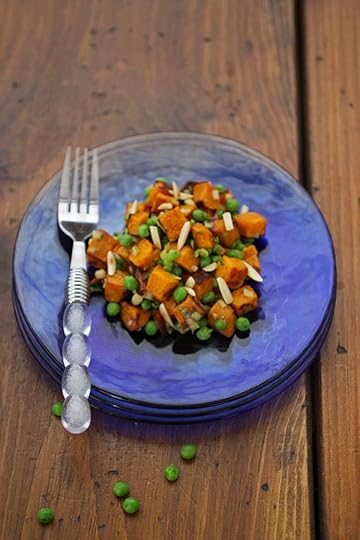 This colorful Roasted Sweet Potato Salad is both a nice change from regular potato salad and an unusual way to serve sweet potatoes. Almond butter provides a creamy richness to the dressing and toasted almonds add crunch.
This colorful Roasted Sweet Potato Salad is both a nice change from regular potato salad and an unusual way to serve sweet potatoes. Almond butter provides a creamy richness to the dressing and toasted almonds add crunch.
Before I share today’s recipe, I want to congratulate Lydia Claire, the winner of last week’s Jazzy Vegetarian’s Deliciously Vegan giveaway contest. Lydia’s favorite easy vegan meal is Pad Thai. Happy cooking, Lydia!
Roasted Sweet Potato Salad with Almond Butter
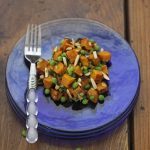
This colorful dish is both a nice change from regular potato salad and an unusual way to serve sweet potatoes. Almond butter provides a creamy richness to the dressing and toasted almonds add crunch.
1 1/2 pounds sweet potatoes
1 tablespoon olive oil
1 cup frozen baby peas, thawed
2 scallions, minced
1/2 cup pineapple or orange juice
1/4 cup almond butter
Salt and ground black pepper
2 tablespoons toasted slivered almonds
Preheat the oven to 400°F. Peel the potatoes and cut them into 1/2-inch dice. Toss with the olive oil and spread on a baking sheet. Roast the potatoes until tender but still firm, about 30 minutes. Allow to cool, then place in a large bowl. Add the peas and scallions, and set aside.
In a small bowl, combine the juice, almond butter, and salt and pepper to taste. Blend well, then pour the dressing over the potato mixture, stirring gently to combine.
Sprinkle with the almonds and serve right away, or cover and refrigerate until ready to serve.
From The Nut Butter Cookbook by Robin Robertson. ©2014 Robin Robertson. Used by permission from Andrews McMeel Publishing. Photo by Lori Maffei.
SaveSave
SaveSave
SaveSave
SaveSaveSaveSave
The post Roasted Sweet Potato Salad with Almond Butter appeared first on Robin Robertson.












February 27, 2018
Cashew Stuffed Artichokes from Jazzy Vegetarian’s Deliciously Vegan
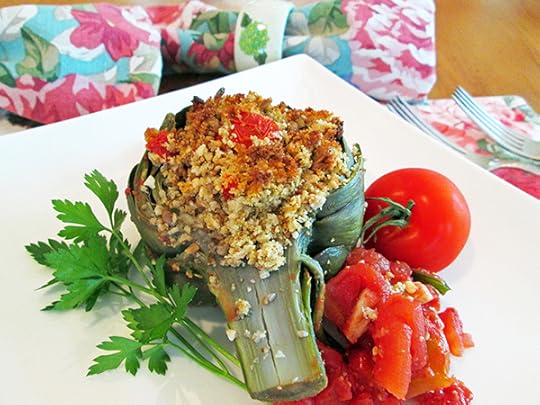 Delicious vegan meals are fun to prepare in your own home kitchen with Laura Theodore’s highly anticipated new cookbook, Jazzy Vegetarian’s Deliciously Vegan: Plant-Powered Recipes for the Modern, Mindful Kitchen. This modern guide to vegan eating is a 320-page cookbook featuring Laura’s recipes (many from her award-winning PBS television show) and includes beautiful full-color photos on nearly every page.
Delicious vegan meals are fun to prepare in your own home kitchen with Laura Theodore’s highly anticipated new cookbook, Jazzy Vegetarian’s Deliciously Vegan: Plant-Powered Recipes for the Modern, Mindful Kitchen. This modern guide to vegan eating is a 320-page cookbook featuring Laura’s recipes (many from her award-winning PBS television show) and includes beautiful full-color photos on nearly every page.
In addition to over 175 flavor-packed, plant-based recipes, Laura helps readers learn what it takes to stock and cook on a daily basis in a well-equipped vegan kitchen, with these essential Top Ten lists:
Ingredients to have on hand at all times in your pantry
Effective egg substitutions for baking
Delicious options for making vegan cheese and cream
Two-ingredient recipes
Herbs and spices to always keep in your kitchen
From simple snack ideas to enticing entrées to mouthwatering desserts, Jazzy Vegetarian’s Deliciously Vegan features delectable main dish recipes like Teriyaki Kebabs, Sunny Black Bean Burgers and Gingered Portobello Steaks. Crowd-pleasing party foods include Guacamole Mini Peppers, Chili-Maple Almonds and Miso Hummus. Vegan Burritos with Tofu Queso Fresca, Golden Cashew Milk and Seitan Fajitas round out diverse dinner menus. And for dessert, Laura has plenty of scrumptious sweets to choose from, like Lively-Lemon Cupcakes, Sweet Potato Pie and Divine Chocolate Mousse Cake.
Highlighting holiday entertaining to everyday ideas for preparing quick and delectable plant-based meals for the family, Laura Theodore’s is the ultimate guide for the vegan home chef.
Would you like to own a copy of Jazzy Vegetarian’s Deliciously Vegan? Just leave a comment at the end of this post telling me your favorite easy vegan meal and you’ll be entered in the giveaway. The giveaway ends on Monday, March 5th at midnight. The winner will be announced on Tuesday, March 6th.
Cashew Stuffed Artichokes

I adore artichokes. I have loved ‘em since I was a little girl and whenever I see beautiful varieties in my marketplace, I cannot resist them. This recipe is festive and filling with cashews and sunflower seeds showcased in a flavorful stuffing. I like to serve this colorful dish as a first course, or they do double duty as a luncheon entrée.
1 can (26 to 28 ounces) diced tomatoes, with juice
2 large cloves garlic. minced
2 slices whole-grain bread, torn into chunks
1/3 cup chopped raw or roasted cashews
1/4 cup roasted, salted sunflower seeds
1 tablespoon fresh chopped basil, or 1 teaspoon dried basil
1/4 teaspoon Italian seasoning blend
1/4 teaspoon sea salt
1 tablespoon extra-virgin olive oil
3/4 cup diced fresh tomatoes
4 medium trimmed and cooked artichokes ((see trimming and cooking instructions in Chef’s Notes))
Preheat the oven to 400 degrees F. Spread the canned tomatoes with juice over the bottom of a 9 by 12-inch or similar sized casserole dish. Sprinkle the minced garlic evenly over the tomatoes.
Put the bread, cashews, sunflower seeds, basil, Italian seasoning and sea salt into a blender or food processor and process into coarse crumbs. Transfer to a medium-sized bowl. Add the olive oil and stir to combine. Add the fresh tomatoes and gently stir, until thoroughly combined.
Arrange the artichoke halves, cut-side up, on top of the tomatoes and garlic in the prepared casserole dish. Stuff each cavity with one-eighth of the cashew/sunflower seed mixture. Cover with foil and bake for 40 to 45 minutes. Uncover and bake for 10 minutes, or until the top of the stuffing is golden brown.
To serve, put some of the tomato sauce from the bottom of the casserole dish on each of eight individual serving plates and top it with 1 stuffed artichoke half (see note). Serve warm or cover, refrigerate and serve cold.
Chef’s notes:
To trim and clean the artichokes, start by cutting off the top 1/2 to 1 inch of each artichoke to remove the spiky tips. Cut off any remaining spiky tips with kitchen shears. Trim away the tough edges of the stem. Rinse each artichoke under cold running water, spreading the leaves to rinse out any residual dirt or sand.
To cook the artichokes, put 3 to 4 inches of water in a deep saucepan large enough to hold all the artichokes snugly so they remain upright as they cook. Stir in the balsamic vinegar, if using. Add the artichokes, making certain they are standing partially upright. Cover and bring to a boil. Cook the artichokes until crisp tender, about 20 minutes. They are done when an outer leaf peels off easily. Remove the artichokes from the pan using tongs and arrange them upside down on a rack set over a large dinner plate to drain and cool.
Once the artichokes are cooked and cooled, you can remove the “choke.” Begin by cutting each artichoke in half, vertically. Scoop out the fuzzy center choke with a grapefruit spoon or teaspoon. If you are cooking the artichokes ahead of time, wrap the artichokes tightly in plastic wrap and refrigerate for up to 1 day before preparing this recipe.
If you are serving this as a luncheon entrée, serve 2 artichoke halves per person.
Recipe by Laura Theodore, from JazzyVegetarian’s Deliciously Vegan. Published by Scribe Publishing, ©2018, reprinted by permission.
SaveSave
The post Cashew Stuffed Artichokes from Jazzy Vegetarian’s Deliciously Vegan appeared first on Robin Robertson.












Robin Robertson's Blog
- Robin Robertson's profile
- 59 followers


